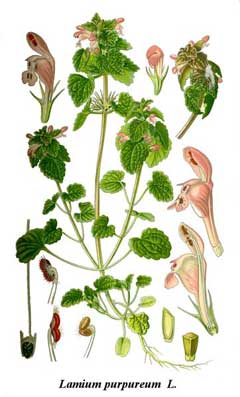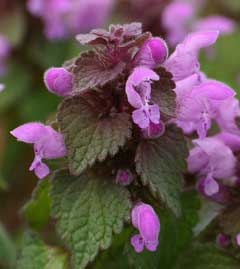 |
|
http://commons.wikimedia.org/wiki/File:Cleaned-Illustration_Lamium_purpureum.jpg |
 |
| http://commons.wikimedia.org/wiki/User:Djlayton4 |
Translate this page:
Summary
Physical Characteristics

 Lamium_purpureum is a ANNUAL growing to 0.3 m (1ft) by 0.2 m (0ft 8in).
Lamium_purpureum is a ANNUAL growing to 0.3 m (1ft) by 0.2 m (0ft 8in).
See above for USDA hardiness. It is hardy to UK zone 4 and is not frost tender. It is in flower from March to October. The species is hermaphrodite (has both male and female organs) and is pollinated by Bees. The plant is self-fertile.
It is noted for attracting wildlife.
Suitable for: light (sandy), medium (loamy) and heavy (clay) soils, prefers well-drained soil and can grow in heavy clay soil. Suitable pH: mildly acid, neutral and basic (mildly alkaline) soils. It can grow in semi-shade (light woodland) or no shade. It prefers moist soil.
UK Hardiness Map
US Hardiness Map
Synonyms
Plant Habitats
Edible Uses
Young leaves - raw or cooked as a potherb[2, 4, 5, 8, 54, 62, 183]. The plant is a short-lived annual, but seeds can germinate at almost any time of the year and so the leaves are often available all year round.
References More on Edible Uses
Medicinal Uses
Plants For A Future can not take any responsibility for any adverse effects from the use of plants. Always seek advice from a professional before using a plant medicinally.
The whole plant is astringent, diaphoretic, diuretic, purgative and styptic[4, 46]. A decoction of the plant is particularly useful for checking any kind of haemorrhage, whilst the fresh bruised leaves can be applied to external cuts and wounds[4].
References More on Medicinal Uses
The Bookshop: Edible Plant Books
Our Latest books on Perennial Plants For Food Forests and Permaculture Gardens in paperback or digital formats.

Edible Tropical Plants
Food Forest Plants for Hotter Conditions: 250+ Plants For Tropical Food Forests & Permaculture Gardens.
More

Edible Temperate Plants
Plants for Your Food Forest: 500 Plants for Temperate Food Forests & Permaculture Gardens.
More

More Books
PFAF have eight books available in paperback and digital formats. Browse the shop for more information.
Shop Now
Other Uses
References More on Other Uses
Cultivation details
An easily satisfied plant, it tolerates most soils and conditions. Grows well in heavy clay soils. Dislikes shade. A common garden weed, usually flowering at almost any time of the year and the seed is capable of germinating even in the winter if the weather is mild[17]. In rich soils the plant can grow quite lushly, in poor soils it will only grow a few centimetres tall before flowering and spreading its seed. The plant is easily controlled, however, and never really becomes a pest[K]. Plants seem to be immune to the predations of rabbits[233]. A good bee plant[4, 24]. Grows well with potatoes[14].
References Carbon Farming Information and Carbon Sequestration Information
Temperature Converter
Type a value in the Celsius field to convert the value to Fahrenheit:
Fahrenheit:
The PFAF Bookshop
Plants For A Future have a number of books available in paperback and digital form. Book titles include Edible Plants, Edible Perennials, Edible Trees,Edible Shrubs, Woodland Gardening, and Temperate Food Forest Plants. Our new book is Food Forest Plants For Hotter Conditions (Tropical and Sub-Tropical).
Shop Now
Plant Propagation
Seed - plants usually self sow freely and should not require human intervention. When required, the seed can be sown in situ as soon as it is ripe.
Other Names
If available other names are mentioned here
Native Range
TEMPERATE ASIA: Lebanon, Syria, Turkey EUROPE: Denmark, Finland (south), United Kingdom, Sweden, Czechoslovakia, Austria, Belgium, Germany, Hungary, Netherlands, Poland, Russian Federation-European part (European part (west)), Estonia, Lithuania, Latvia, Ukraine (incl. Krym), Former Yugoslavia, Bulgaria, Greece (Kríti), Italy (incl. Sardinia), Romania, Spain, France (incl. Corsica), Portugal AFRICA: Spain (Canarias), Portugal (Madeira Islands), Algeria (north), Morocco (north)
Weed Potential
Right plant wrong place. We are currently updating this section.
Please note that a plant may be invasive in one area but may not in your area so it’s worth checking.
Conservation Status
IUCN Red List of Threatened Plants Status :

Growth: S = slow M = medium F = fast. Soil: L = light (sandy) M = medium H = heavy (clay). pH: A = acid N = neutral B = basic (alkaline). Shade: F = full shade S = semi-shade N = no shade. Moisture: D = dry M = Moist We = wet Wa = water.
Expert comment
Author
L.
Botanical References
17
Links / References
For a list of references used on this page please go here
Readers comment
| Add a comment |
|
If you have important information about this plant that may help other users please add a comment or link below. Only comments or links that are felt to be directly relevant to a plant will be included. If you think a comment/link or information contained on this page is inaccurate or misleading we would welcome your feedback at [email protected]. If you have questions about a plant please use the Forum on this website as we do not have the resources to answer questions ourselves.
* Please note: the comments by website users are not necessarily those held by PFAF and may give misleading or inaccurate information.
To leave a comment please Register or login here All comments need to be approved so will not appear immediately.
|
Subject : Lamium_purpureum
|
|
|
|